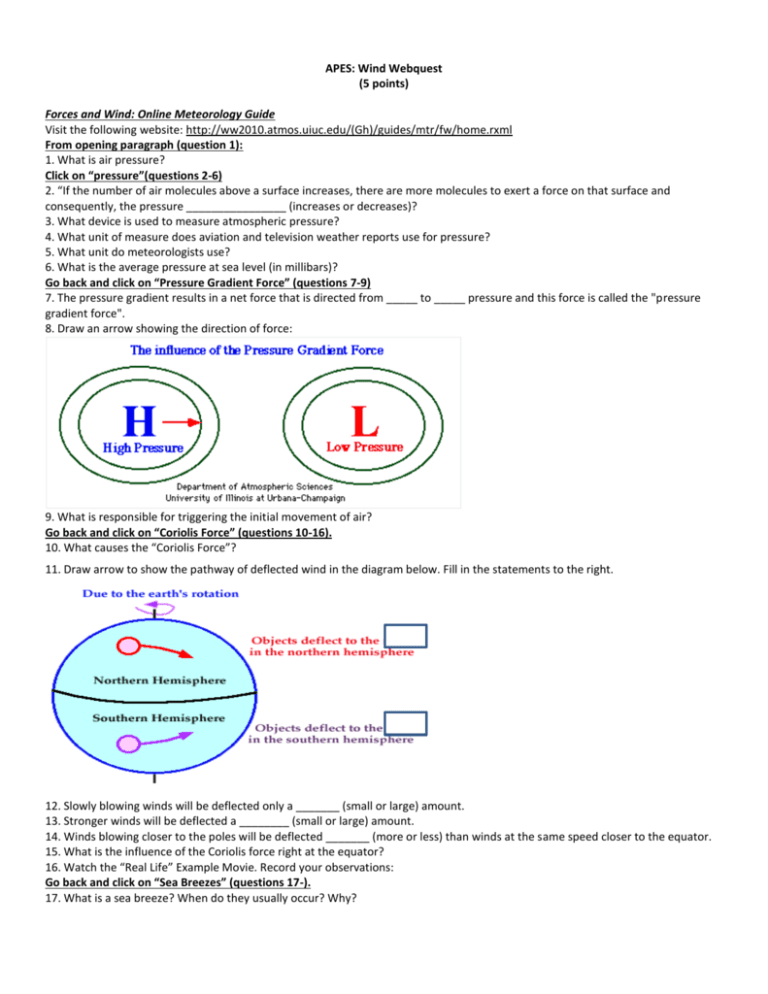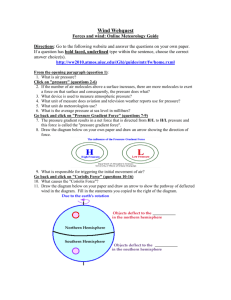APES: Wind Webquest (5 points) Forces and Wind: Online
advertisement

APES: Wind Webquest (5 points) Forces and Wind: Online Meteorology Guide Visit the following website: http://ww2010.atmos.uiuc.edu/(Gh)/guides/mtr/fw/home.rxml From opening paragraph (question 1): 1. What is air pressure? Click on “pressure”(questions 2-6) 2. “If the number of air molecules above a surface increases, there are more molecules to exert a force on that surface and consequently, the pressure ________________ (increases or decreases)? 3. What device is used to measure atmospheric pressure? 4. What unit of measure does aviation and television weather reports use for pressure? 5. What unit do meteorologists use? 6. What is the average pressure at sea level (in millibars)? Go back and click on “Pressure Gradient Force” (questions 7-9) 7. The pressure gradient results in a net force that is directed from _____ to _____ pressure and this force is called the "pressure gradient force". 8. Draw an arrow showing the direction of force: 9. What is responsible for triggering the initial movement of air? Go back and click on “Coriolis Force” (questions 10-16). 10. What causes the “Coriolis Force”? 11. Draw arrow to show the pathway of deflected wind in the diagram below. Fill in the statements to the right. 12. Slowly blowing winds will be deflected only a _______ (small or large) amount. 13. Stronger winds will be deflected a ________ (small or large) amount. 14. Winds blowing closer to the poles will be deflected _______ (more or less) than winds at the same speed closer to the equator. 15. What is the influence of the Coriolis force right at the equator? 16. Watch the “Real Life” Example Movie. Record your observations: Go back and click on “Sea Breezes” (questions 17-). 17. What is a sea breeze? When do they usually occur? Why? 18. Draw an arrow showing the direction of the wind: 19. Which warms more rapidly: a large body of water or the land? 20. What is a "land breeze"? When do they usually occur? Why? 21. Where are “land breezes” the strongest? 22. Draw and arrow on the diagram below showing the direction of the wind: 23. Which cools more rapidly: air over land or air over water? Local Wind & Weather. Visit: http://www.signonsandiego.com/ Click on “Weather” (scroll down…it will be listed on the left side under “resources”) 1. What is the direction and strength of the wind currently in San Diego? 2. Click on “Satellite/Radar”. Click on “local Nexrad radar”. Describe what you see: 3. Click on “Local Forecast”. What do meteorologists predict the weather will be like the rest of this week? “Drawing Isobars”: Visit the following website: http://www.uwsp.edu/geo/faculty/ritter/geog101/textbook/manuals/instructor_manual/how_to/drawing_isobars.html Isobars connect points of equal pressure on a weather map. Meteorologists can use isobars to determine the location of LOW and HIGH pressure systems, which can help them predict the weather. Click on the green right arrow to start the activity. 1. What is the LOW pressure isobar on the map? 2. How many millibars separate the isobars on the map? 3. Assume that there is a HIGH pressure system WEST of the map (Minnesota). Which direction do you predict the wind to move. (to the west or to the east). Why? 4. What do you think the weather is like around the LOW pressure? (clear or cloudy) 5. The closer the isobars, the greater the pressure gradient, and the (stronger or weaker) the wind? Extension: The Fremont School District uses oil to heat school buildings. Go Green! is a new project the district will implement. The superintendent has declared that the district will dedicate itself to reducing its carbon footprint. In addition to taking serious energyconservation measures, the district is planning to help offset its carbon dioxide emissions by raising money to help conserve a portion of a large tract of forest land adjacent to the high school campus. (a) Describe one alternative energy source that would reduce the carbon footprint of the school district. Discuss one environmental benefit (other than reduced CO2 emissions) and one environmental drawback of using the alternative source instead of fuel oil. (b) Identify TWO ecological benefits provided by intact forest ecosystems (other than reducing CO2 levels in the atmosphere). (c) Use the assumptions below to answer the questions that follow. For each calculation, show all work. The biomass of the forest increases at an annual rate of 2.7 × 105 kg/ha. The forest biomass is 50 percent carbon by mass. Each year the district uses 3.0 × 105 gallons of fuel oil for heating and hot water. 10 kg of CO2 is produced when 1 gallon of fuel oil is burned. 1.0 kg of CO2 contains 0.27 kg of carbon. The cost of putting 1 ha of the forest into conservancy is $12,000. (i) Calculate the mass of carbon, in kg, that is accumulated and stored in 1.0 ha of forest in one year. (ii) Calculate the mass of carbon, in kg, that is emitted by the school as a result of its fuel-oil consumption in one year. (iii) Calculate the number of hectares of forest the school district needs to conserve in order to offset the carbon released in one year by the school burning its fuel oil. (iv) Calculate the amount of money the school district must raise for the conservation project.











